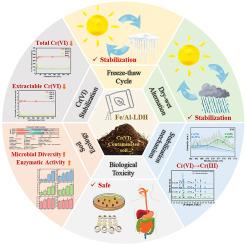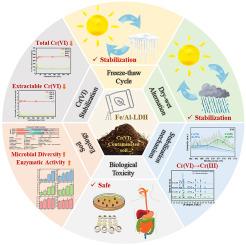Fe(II)/Al层状双氢氧化物对污染土壤中Cr(VI)的还原稳定特性、长期稳定性及生物毒性评价
IF 7.3
2区 环境科学与生态学
Q1 ENVIRONMENTAL SCIENCES
引用次数: 0
摘要
铬(Cr)由于其不同的氧化态,往往导致长期有效性不足,对土壤修复提出了重大挑战。本研究合成了还原稳定效果优异的Fe/Al-LDH修复Cr(VI)污染土壤,并进行了超过360天的长期培养实验。两种土壤的Cr(VI)浓度均显著降低,稳定效率分别达到99.82%和87.93%。即使经过多次冻融和干湿循环,修复后BS和YS土壤的淋溶浓度仍保持在相应的标准限值内。此外,Fe/Al-LDH的施用显著提高了植物的发芽指数,尤其是根长。此外,体外生物可及性和土壤膜扩散梯度萃取实验结果表明,处理组Cr的生物可及性显著降低。修复后,土壤酶活性、微生物种类丰富度和多样性均有所增加。关键Cr(VI)还原微生物芽孢杆菌的相对丰度由17.57%上升至19.46% ~ 30.24%,进一步促进了Cr污染的协同修复。因此,本研究为经济、环保、高效的Cr(VI)污染治理项目修复提供了技术支持。本文章由计算机程序翻译,如有差异,请以英文原文为准。


Reduction-stabilization characteristics, long-term stability and biotoxicity evaluation of Fe(II)/Al layered double hydroxides on Cr(VI) in contaminated soil
Chromium(Cr) poses a significant challenge for soil remediation due to its varying oxidation states, which often result in insufficient long-term effectiveness. In this study, Fe/Al-LDH with an excellent reduction-stabilization effect was synthesized for the remediation of Cr(VI)-contaminated soil, and long-term incubation experiments were conducted over 360 days. The Cr(VI) concentration in both soil types decreased significantly, with stabilization efficiencies reaching 99.82 % and 87.93 %, respectively. Even after multiple freeze-thaw and dry-wet cycles, the leaching concentrations of BS and YS soils remained within the corresponding standard limits after remediation. Moreover, the application of Fe/Al-LDH significantly enhanced plant germination indices, particularly root length. Furthermore, results from in vitro bioaccessibility and soil film diffusion gradient extraction experiments indicated a notable reduction in Cr bioaccessibility within the treatment group. Following remediation, soil enzyme activity, microbial species richness, and diversity increased. The relative abundance of Bacillus, a key Cr(VI)-reducing microorganism, rose from 17.57 % to 19.46 %–30.24 %, further contributing to the synergistic remediation of Cr pollution. Hence, this study provides technical support for the economic, environmentally friendly, and efficient remediation of Cr(VI) pollution control projects.
求助全文
通过发布文献求助,成功后即可免费获取论文全文。
去求助
来源期刊

Environmental Pollution
环境科学-环境科学
CiteScore
16.00
自引率
6.70%
发文量
2082
审稿时长
2.9 months
期刊介绍:
Environmental Pollution is an international peer-reviewed journal that publishes high-quality research papers and review articles covering all aspects of environmental pollution and its impacts on ecosystems and human health.
Subject areas include, but are not limited to:
• Sources and occurrences of pollutants that are clearly defined and measured in environmental compartments, food and food-related items, and human bodies;
• Interlinks between contaminant exposure and biological, ecological, and human health effects, including those of climate change;
• Contaminants of emerging concerns (including but not limited to antibiotic resistant microorganisms or genes, microplastics/nanoplastics, electronic wastes, light, and noise) and/or their biological, ecological, or human health effects;
• Laboratory and field studies on the remediation/mitigation of environmental pollution via new techniques and with clear links to biological, ecological, or human health effects;
• Modeling of pollution processes, patterns, or trends that is of clear environmental and/or human health interest;
• New techniques that measure and examine environmental occurrences, transport, behavior, and effects of pollutants within the environment or the laboratory, provided that they can be clearly used to address problems within regional or global environmental compartments.
 求助内容:
求助内容: 应助结果提醒方式:
应助结果提醒方式:


